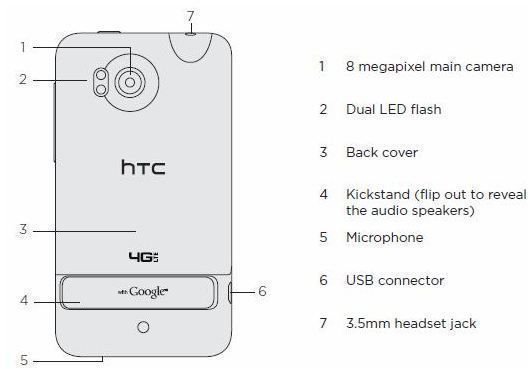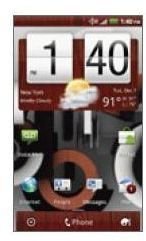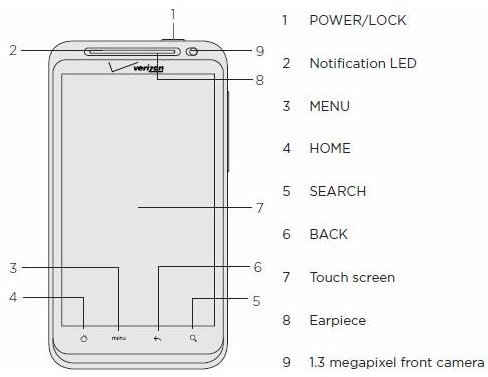HTC Thunderbolt User Guide
Setting up the HTC Thunderbolt

When you first receive the HTC Thunderbolt, insert the 4G SIM card and the microSD memory card into the phone. Follow these steps from the HTC Thunderbolt user guide:
- Remove the backcover.
- Take the battery out.
- Slide out the SIM card holder, which is located on the bottom part of the compartment.
- Hold the SIM card so that the gold contacts are facing down and the cutout corner is facing out. Then insert the SIM card into the SIM card slot.
- Insert the microSD memory card into the storage card slot, located in the upper right portion of the compartment. Have the gold contacts facing down and push the card into the slot until it clicks.
- Place the battery back in its compartment and place the backcover over it.
Once everything is in place, charge the battery. Connect the power adapter cable to the USB port of the phone. After the phone is completely charged, turn on the phone. To do this, press and hold the Power button until the screen turns on. The first thing to do is to set up the phone. Follow the on-screen instructions. You will be asked to set the Language and whether or not to have your current location detected automatically.
Home Screen and Notifications

After going through the initial set up, you will see the home screen. The first thing to notice is the weather clock widget which displays the current time and weather conditions. As you personalize the home screen it may become a bit crowded, so you can create multiple home screens. Up to seven home screens are possible with the HTC Thunderbolt. Slide your finger horizontally across the screen to the left or right to view the additional home screens. Press the Home key to return to the main home screen. To view all seven home screens in thumbnail view, press the Home key while on the main home screen or pinch the screen.
On top of the home screen is the status bar. It contains status icons such as signal strength, battery status, and Bluetooth connections to HTC Thunderbolt accessories. The status bar also contains notifications for new messages, missed calls, and upcoming events. Notifications are also displayed on top of the phone through LED lights. The HTC Thunderbolt user guide states that a solid green light indicates that the phone is connected to a computer or power adapter and the battery is fully charged. It is a solid red light when the battery is charging. When the battery is low, the LED light is red and it is flashing. When there is a pending notification, the green light flashes.
When several notifications are available, you can easily view them all by opening the notification panel. To do this, press and hold the status bar and slide your finger downward. In addition to the notifications, the recently opened apps are listed and accessible from the panel. To close the notification bar, press the Back button or press and hold the bottom bar of the notification panel and slide your finger up the screen.
Making Calls, Answering Calls, Volume Controls
The main function of the HTC Thunderbolt is to make and receive phone calls. To make a call, press the Home key and then press the Phone key. Type the phone number using the on-screen keypad and then tap the Call button. If the number dialed is in the phone’s contacts, the name and number will pop up as you type. Tap the contact to make the call.
When a call comes in, the incoming call screen appears and displays the caller ID. To answer the call, press Answer. To ignore the call, press Decline. If the phone is locked and a call is received, drag the bar with the caller ID on the lock screen downward to answer the call. To reject the call, drag the bar upward, or press the Menu key and press Decline.
There are several options during a call. Follow these steps in the HTC Thunderbolt user guide:
- To put a call on hold, press the Menu key and tap Hold. To resume the call, press Menu and select Unhold.
- To answer a second call, tap Answer. This puts the first call on hold. To switch back, tap the person’s caller ID, which is displayed on the screen.
- To end the current call, tap End call.
- To mute the call or place the call on speakerphone, press the respective option on the call screen.
The volume of the ringer and various media sounds can be adjusted by following these steps in the HTC Thunderbolt user guide:
- To adjust the ringer volume or earpiece volume press the Volume Up or Volume Down buttons on the right side of the phone.
Scenes, Widgets, Icons, and Ringtones

The exterior of the phone can be personalized with HTC Thunderbolt cases, while the phone software can be personalized with scenes, widgets, icons, and ringtones. A scene has a pre-selected set of widgets and wallpapers.
- To set a scene, press the Home key, then press the Personalize button then select Scene. Slide your finger left and right to browse through the available scenes. Select the one you want and click Apply.
- To change the wallpaper, press Home, then press the Personalize button, and select Wallpaper. Choose from HTC wallpapers, Live wallpapers, or Gallery.
- To add a widget, go to a part of the home screen that is empty and press the Personalize button and then select Widget. Find the one you want and press Select.
- To add an icon or shortcut, go to an open area on the home screen and press the Personalize button. Tap App and select an app shortcut from the list to add an app icon to the home screen. Tap Shortcut for a home screen shortcut for a particular setting.
- To add a ringtone, press the Home key, then press the Personalize button. Select Sound Set. Tap a sound set name. To sample the sounds, press the Play button. Choose the ringtone you want and press Apply.
References
- HTC Thunderbolt Manual - http://www.verizonwireless.com/multimedia/mim/htc_thunderbolt/thunderbolt_manual.pdf
- Image Credit - Images courtesy of http://www.verizonwireless.com
